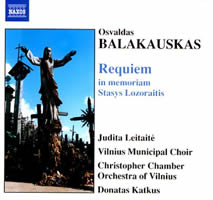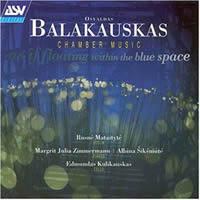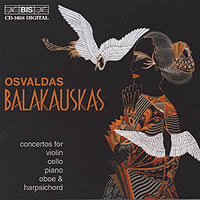Two Recent Requiems
|
Grant Chu Covell [June 2005.]
Valentin SILVESTROV: Requiem for Larissa (1997-99). National Choir of Ukraine “Dumka,” National Symphony Orchestra of Ukraine, Volodymyr Sirenko (cond.). ECM New Series 1778 (http://www.ecmrecords.com/). I first encountered Silvestrov’s music on col legno AU 31840, “Festival ALTERNATIVA: Moskau 9.–23. Oktober 1989,” a five-CD brick (O/P) offering the 1982 song cycle, Stufen, an atonal 1967 piano Elegy (with Silvestrov champion Alexei Lubimov), and the “post-Romantic” Fifth Symphony (1980-82). The moody, languid symphony greatly impressed me. Looking past the archetypical sentimental gestures ripped from Mahler, the 41-minute single movement suggests an emotionally stunted land filled with threadbare clichés. Silvestrov subtly varies a limited thematic set for the work’s duration. But the static music is never self-indulgent. He mines emotion from the ruins. It’s a despairing symphony representing a point of no return, possibly music’s end. I had never heard anything quite like it. Col legno’s recording, hazy around the edges and lacking finesse, lends the symphony an appropriately tragic air. Under Arvo Volmer, the Estonia State Symphony Orchestra sounds in awe of the score and somewhat underprepared. The music and the performance could collapse at any moment. Other recordings, neater and more polished (also four or five minutes longer), don’t match its sense of malaise and abandonment. I find David Robertson and the Deutsches Symphonie-Orchester Berlin (Sony SK 66 825, O/P) too efficient, almost arrogant, and the Kiev Conservatoire Symphony Orchestra under the symphony’s dedicatee, Roman Kofman (BMG 74321 49959 2, O/P), coolly refined. (I’ve not heard Megadisc 7836 with Andrej Borejko and the Ural Philharmonic.) It’s not as if the Fifth is complex. Between clenched outbursts, wind and string lines slice through lean held chords. If the filigree is too precise, the blurred effect is lost. If the lines sound too purposeful, a false sense of progress mars the mood. After hearing the Fifth, I sought out other Silvestrov. Nothing else satisfied until now. (I definitely favor the orchestral works. See Walt’s appraisal of the song cycle, Stufen, and a chamber music disc.) The Requiem re-enters the symphony’s barren terrain. Its circumstances are tragic; Larissa (or Larysa) Bondarenko, Silvestrov’s wife, died unexpectedly in 1996. The composer was stunned. The Requiem’s seven movements were written for her, encapsulating their joint experiences through reflections upon his own compositions and the music they shared (she was the 1963 First Symphony’s dedicatee). The fourth movement transcribes a voice / piano setting from Silent Songs (1974/77) and the fifth movement absorbs a piano piece, Der Bote (1996/97). The Requiem doesn’t really conclude. It recycles, gently rummaging through Silvestrov’s portmanteau of Romantic gestures and remembrances. Since the mid-’70s, revisiting older music has been a key strategy for this Ukrainian. He wasn’t always like this. In the 1960s he played with serialism and aleatoric structures. Boulez programmed him at the Domaine Musicale, and Maderna conducted his Third Symphony, “Eschatophony,” at Darmstadt in 1968. His “post-Romantic” catalog includes works in all forms, several titles overtly proclaiming their self-reflexivity: piano postludes, Post scriptum for violin and piano, Postludium for piano with orchestra. (Metamusik, a “symphony for piano and orchestra,” is in turn built from Postludium.) Silvestrov called his Fifth a “post-symphony.” The composer intended to put his pen down after completing the Requiem. But some small pieces followed, and then he took up large-scale works again with a Seventh Symphony. Silvestrov’s somber, well-intentioned Requiem may nonetheless infuriate prospective listeners. The text is fragmented, but not in a Dadaist way. It’s as if Silvestrov can’t remember all of the words, or perhaps he’s reading a monument’s inscription weathered by time. According to the notes, the opening Largo, behaving somewhat like a Kyrie, is merely:
The opening three movements and the chorus-plus-orchestra transcription of lines from Taras Shevchenko’s “The Dream,” in the fourth, feel conventional despite the bare textures, open fifths, deep brass, piano tremolos and glacial pacing. There’s ample thunder in the second movement, where one anticipates a Dies Irae. The modest-sized orchestra includes a synthesizer for low bell tones and held chords. Gestures using the pitches A-D-C# (“Larissa” transliterated as la–re–cis) in different arrangements predominate. Several forceful eruptions feature the motive as A descending to C# then rising a ninth to D. But then the fifth movement, with the words “Agnus Dei / miserere nobis / Agnus Dei / dona nobis pacem,” enters a different place. The frail music sounds like Mozart, though not directly attributable to any specific composition. With its sunny Alberti bass, it sounds like juvenilia, an uninspired Mozart contemporary, or something facile for a music-box. Silvestrov arranged Der Bote (“The Messenger” or “The Herald”) because it was one of the last pieces his wife heard. (Lubimov closes ECM New Series 1771 with a superbly tender reading. The recital also includes the tart Webern-like Elegy.) The synthesizer contributes whooshing wind sounds, which also appear in the strings-plus-piano version on Gidon Kremer’s After Mozart (Nonesuch 79633-2). It’s not clear who the messenger is, what may be heralded, or whose point of view Silvestrov presents. This cotton-candy tuft following many gloomy pages, introducing irony, may seem maudlin or sarcastic. For a few moments we step outside, inadvertently bumping into angels. The remaining two movements reduce the requiem text further, the despondent atmosphere restored. I hear the Fifth Symphony echoed in the concluding movement. Lacking scores, I can’t be completely sure, but some of the same upward gestures are there. We return, barely cleansed of grief, but changed. Butchered texts and anachronistic stylistic shifts will upset those expecting Verdi’s grandeur or Fauré’s delicacy. I suspect Silvestrov’s boldness will alienate many. As with the Festival Alternativa’s Fifth, this gently blurred and occasionally fuzzy performance is perfect. No soloists are indicated, yet individual voices do emerge. Some music commands absolute silence after the last bar: the Mozart and Brahms Requiems, Mahler’s Ninth, Tchaikovsky’s Sixth, and Berg’s Violin Concerto, to name a few. Silvestrov’s Requiem definitely belongs to that category.
Osvaldas BALAKAUSKAS: Requiem in memoriam Stasys Lozoraitis (1995). Judita Leitaitė (sop.), Vilnius Municipal Choir “Jauna Muzika,” Christopher Chamber Orchestra of Vilnius, Donatas Katkus (cond.). Naxos 8.557604 (http://www.naxos.com/). Ages ago, a tip from a friend: Keep an ear out for Balakauskas. Soviet constraints isolated this Lithuanian from contemporary music’s dominant streams. Consequently his compositions sounded irregular as they strived for modernity behind thick walls. (Also consider Georgi Minchev — or Mintchev — a worthy Bulgarian who in the mid-’70s crossed Tchaikovsky with Messiaen.) Some Balakauskas pieces employ serialist techniques to rows containing fewer than 12 pitches. Other works might employ scales with more than seven notes. Minimalism and jazz also figure in.
A chamber music collection (ASV CD DCA 1063) combining violin, cello and piano demonstrates Balakauskas’ eclecticism. Among the seven works, the three for violin and piano demonstrate the width of his interests. The preoccupied Like the Touch of a Sea Wave (1975) sounds as if some of the melodies were accidentally rubbed out. Juggling a small chord set, the busy Maggiore-Minore (1994) features wide leaps, repeated notes and broken arpeggios. The engaging Rain for Cracow (1991) loops crooked phrases in a stuttering take on minimalism. Bop-Art, a 1995 cello / piano duo, reflects jazz, while a two-movement piano trio, Retrospective (1974), opens with a whinnying multi-octave glissando similar to other mid-’70s kitchen-sink operas. Several works suffer from recording artifacts. Released in 2000, BIS 1058 collects four concertos. We meet three players from the 1999 ASV disc: Rusne Mataityte (violin), Edmundas Kulikauskas (cello) and Margrit Julia Zimmermann (piano). They are supported by the St. Christopher Chamber Orchestra of Vilnius conducted by Donatas Katkus. Here Balakauskas’ palette suggests piquant Martinů, especially in the 1981 Concerto for Oboe, Harpsichord and Strings. Concerto Brio (1999) for violin and chamber orchestra twists with blues-tinged scales. Ludus modorum for cello and chamber orchestra (1972) straddles styles, while the small but very fine Concertino for Piano and Strings (1966, ’94) sports serialist clothes. The 1995 Requiem in memoriam Stasys Lozoraitis belongs to an altogether different class. Between 1992 and ’94, Balakauskas was Lithuanian ambassador to France, Spain and Portugal. A fellow diplomat, Stasys Lozoraitis represented Lithuania at the Vatican and America during the Soviet period. Later Lozoraitis ran unsuccessfully for his country’s presidency. He died in 1994 and was mourned by his countrymen. This requiem sounds purposeful and anchored. I sense that Balakauskas was deeply moved. With its antique flavor and modest orchestration (a single flute, oboe, clarinet and trombone against chorus, strings and synthesizer sounding like harpsichord), the continually halting phrases and uneasily winnowing melodies indicate a fully confident composer. Here he is unpretentious, introverted and less eclectic. In 12 movements, Balakauskas’ only religious composition follows the standard text. The opening plainchant gesture reappears, extensively varied, at several points. Vocal and instrumental lines are tinged with melismatic quivering — an anchored vessel’s gentle rocking in a snug harbor. The Requiem is restless, alternately calming and questioning. Listeners may hear Pärt in the bare textures; others may recall Martin or Martinů. Some moments approach the Fauré Requiem’s fragile beauty. Judita Leitaitė, a forceful vocal soloist a bit rough around the edges, is clearly in awe of Balakauskas’ engaging composition, the appeal of which magnifies on successive listenings.
[More Grant Chu Covell]
[More
Balakauskas, Silvestrov]
[Previous Article:
Seven Poems on Music]
[Next Article:
Netherlands Winds and Friends]
|



